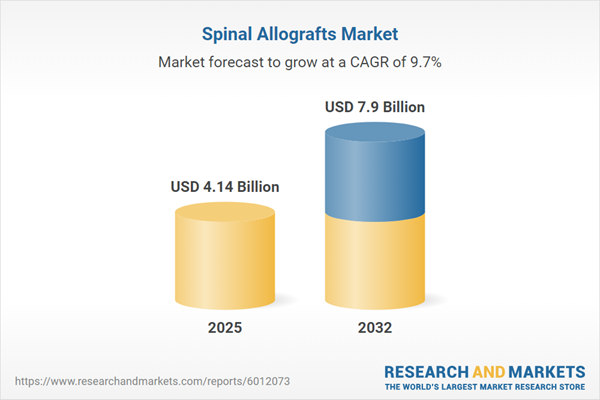Speak directly to the analyst to clarify any post sales queries you may have.
Senior decision-makers in the spinal allografts market face a landscape shaped by advancing clinical needs and rapid technology adoption, requiring strategies grounded in up-to-date intelligence to achieve sustained growth and compliance.
Market Snapshot: Spinal Allografts Market Size & Growth Outlook
The spinal allografts market is registering strong expansion, with a market value rising from USD 3.77 billion in 2024 to USD 4.14 billion in 2025, reflecting a compound annual growth rate (CAGR) of 9.66%. This trajectory is fueled by greater prevalence of spinal disorders, continual innovation in surgical techniques, and advances in allograft materials. The competitive environment is marked by the introduction of next-generation products, streamlined regulatory adaptation, and strengthened market positioning. Increasing cross-sector partnerships and evolving models of care delivery provide fresh opportunities, with the market forecast to achieve notable progress through 2032.
Scope & Segmentation of the Spinal Allografts Market
- Product Types: Cancellous, cortical, and blended cortical-cancellous allografts serve a spectrum of surgical requirements, offering both structural support and enhanced bone healing options tailored to routine or complex applications.
- Graft Processing Methods: Demineralized, freeze-dried, fresh frozen, and preserved methods enable providers to maximize inventory control, optimize logistics, and meet a range of clinical scenarios efficiently.
- Graft Forms: Blocks, chips, fibers, powders, and putties are designed for diverse reconstructive and minimally invasive interventions, matching varying anatomical and procedural needs.
- Applications: Disk replacement and spinal fusion remain essential, addressing both cervical and lumbar conditions and broadening therapeutic possibilities across different patient groups.
- End Users: Ambulatory surgical centers, hospitals, and specialty clinics procure spinal allografts as needed, responding to case complexity, patient profiles, and institutional capabilities.
- Geographic Regions: Americas, Europe, Middle East & Africa, and Asia-Pacific each present unique regulatory environments and payment systems. Leading adoption occurs in the US and Germany, while significant growth is observed in China and India, reshaping regional market dynamics.
- Leading Companies: Medtronic plc, Johnson & Johnson, Stryker Corporation, NuVasive Inc., Zimmer Biomet Holdings Inc., SeaSpine Holdings Corporation, RTI Surgical Inc., Orthofix Medical Inc., LifeNet Health Inc., and AlloSource Inc. drive innovation and help define product standards across this competitive landscape.
Key Takeaways for Senior Decision-Makers
- Biologically enhanced allografts deliver reliable procedural outcomes in advanced surgeries, promoting efficiency for healthcare teams and better experiences for patients.
- The rise of personalized grafts, enabled by advanced biomaterials and 3D printing, allows tailored solutions for specialized procedures and supports growing interest in precise interventions.
- Enhanced traceability systems and strict quality controls help organizations meet changing regulatory expectations, supporting confidence among all clinical and procurement stakeholders.
- Digital supply chain solutions, including blockchain-based tracking, are increasing operational transparency during the allograft delivery cycle and supporting continuous improvements in service continuity.
- Integrated growth factors and cell-based augmentation support expanded treatment options for challenging spinal cases, helping specialists reach patient populations previously limited by technology constraints.
- Industry consolidation and dedicated investment in clinical training are accelerating the market reach of new products and helping standardize best practices, resulting in improved care across both mature and emerging regions.
Tariff Impact: Navigating Regulatory and Supply Chain Pressures
Recent changes in U.S. tariff policies have affected raw material costs and complicated cross-border logistics for spinal allograft suppliers. In response, many organizations are pivoting to domestic manufacturing, enhancing supply chain efficiency, and deploying new preservation and packaging technologies. These proactive steps build resilience while maintaining alignment with quality and regulatory standards across diverse international settings.
Methodology & Data Sources
This market analysis utilizes data from peer-reviewed publications, clinical trial registries, and reputable regulatory sources. Insights are informed by surgeons and procurement specialists, with expert validation processes in place to ensure all findings are accurate and relevant for executive decision-making.
Why This Report Matters
- Delivers actionable intelligence to C-suite leaders, aiding in proactive management of technology trends and regulatory uncertainty across the spinal allograft sector.
- Supports benchmarking for risk and opportunity, facilitating informed prioritization for investments and market entry strategies across multiple geographies and product lines.
- Enables leadership teams to make evidence-based choices around solution adoption and resource allocation, maintaining alignment with evolving business priorities.
Conclusion
Access to timely, actionable insights positions spinal allograft market leaders for success amid regulatory changes, evolving technology, and regional variability—helping organizations strengthen their competitive position for the future.
Additional Product Information:
- Purchase of this report includes 1 year online access with quarterly updates.
- This report can be updated on request. Please contact our Customer Experience team using the Ask a Question widget on our website.
Table of Contents
3. Executive Summary
4. Market Overview
7. Cumulative Impact of Artificial Intelligence 2025
Companies Mentioned
The companies profiled in this Spinal Allografts market report include:- Medtronic plc
- Johnson & Johnson
- Stryker Corporation
- NuVasive, Inc.
- Zimmer Biomet Holdings, Inc.
- SeaSpine Holdings Corporation
- RTI Surgical, Inc.
- Orthofix Medical Inc.
- LifeNet Health, Inc.
- AlloSource, Inc.
Table Information
| Report Attribute | Details |
|---|---|
| No. of Pages | 192 |
| Published | October 2025 |
| Forecast Period | 2025 - 2032 |
| Estimated Market Value ( USD | $ 4.14 Billion |
| Forecasted Market Value ( USD | $ 7.9 Billion |
| Compound Annual Growth Rate | 9.6% |
| Regions Covered | Global |
| No. of Companies Mentioned | 11 |









